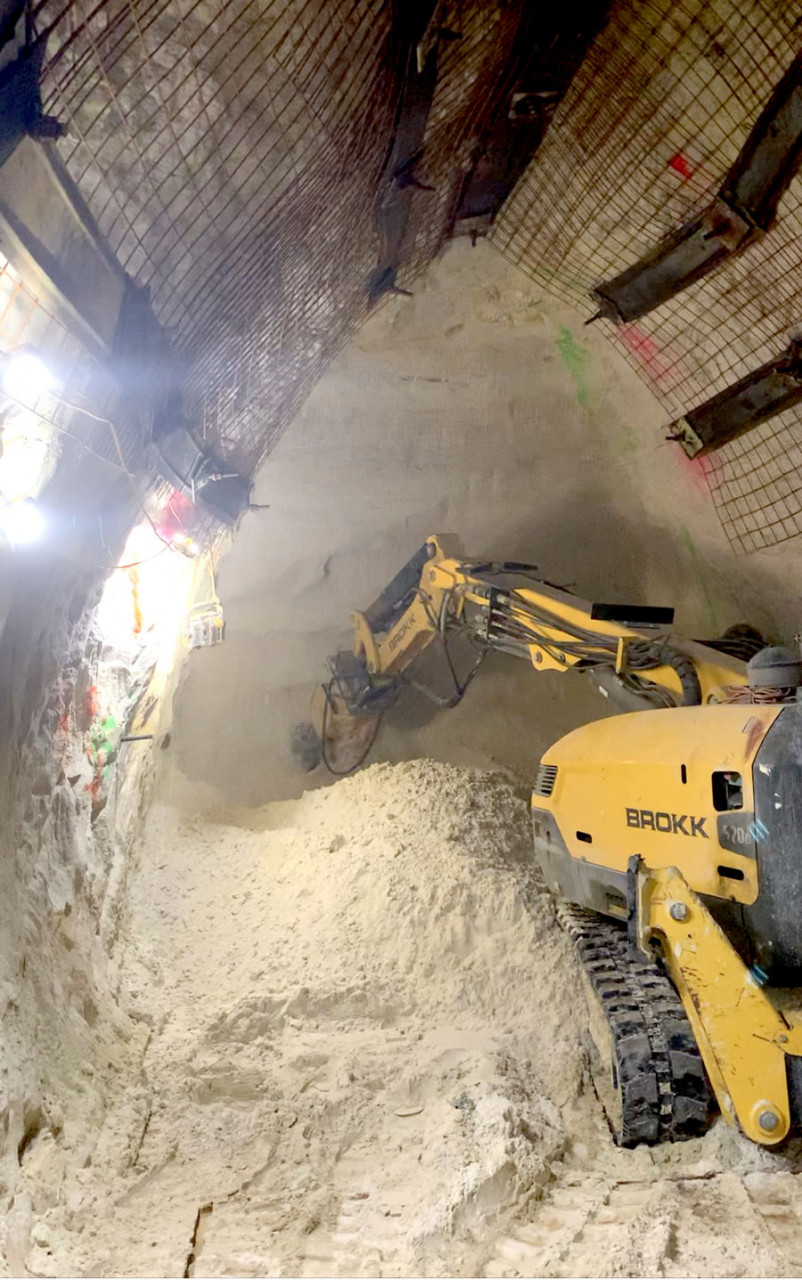Out of Sight, But Not Out of Mind

20 December 2023 News articles
The largest city in Minnesota, Minneapolis, is home to a bustling population of more than 425,000 citizens and is supported through extensive underground infrastructure — most of which is decades old. The most pressing concern when it comes to this infrastructure is the deterioration of the stormwater tunnels beneath the city.
PCiRoads, a highway and heavy civil general contractor, won the bid for a three-year project enlarging portions of the existing stormwater tunnel, constructing a new parallel tunnel and creating new tunnel access in downtown Minneapolis. They partnered with our team to rework more than 800 feet of stormwater tunneling and mine 3,600 feet of new parallel tunnel. The final system is 4,200 feet long.
The Project
In 2021, the City of Minneapolis Public Works Department approved the Central City Parallel Storm Tunnel Project, a $60 million overhaul of the stormwater tunnel system, after finding evidence of cracking, breaking and other concrete deterioration from the strain of excessive amounts of water running through the tunnels.
“When the stormwater tunnels start to fail, we see dangerous flooding and other damages to underground infrastructure,” said Nap Scott, estimator and project manager for PCiRoads. “The repair of the current system and addition of the parallel stormwater tunnel will be a huge step forward in handling the increased demands of the city.”
The plan is to create a tunnel twice the size of the current system to move stormwater from downtown Minneapolis to the Mississippi River. The project will increase the lifespan of the current system, reduce annual repair costs and provide additional support for rainwater runoff with the goal of lasting another 100 years.
Tight Spaces
The PCiRoads crew faced a few logistical challenges with the Central City Parallel Storm Tunnel Project, the first being that the workers and equipment for the project needed to be lowered down by crane 80 feet into the system. PCiRoads’ 12 years of experience in the tunneling industry gave them a leg up in choosing the perfect equipment for such a large project. In the past, they used BROKK DEMOLITION ROBOTS for similar, smaller-scale projects.
For this project, PCiRoads purchased two new BROKK 520DS and a used Brokk 400 diesel model. A 6-ton Brokk 520D is 5.25 feet wide, with a vertical reach of 23.4 feet. To get the same hitting power as a Brokk 520D, they would need to use a 10-ton excavator with a width of approximately 7 feet and a vertical reach of 8 feet. The lighter weight and smaller size of the robots made lowering them down the tunnel’s 80-foot shaft easier and safer than larger equipment.
“The Brokk diesel models are easier to power since they don’t need a generator — but that means we needed to make sure there was proper ventilation in the tunnels before we could start,” Scott said. “Once it was set up, the diesel models offered unparalleled versatility because we didn’t need to worry about generators or cords.”
Versatility & Safety
PCiRoads took advantage of the Brokk demolition robots by using MULTIPLE ATTACHMENTS throughout the project: the Brokk Drum Cutter 250, the Brokk Hydraulic Breaker 705 and the TEI 326-240 Rockdrill. For mining the new tunnel, they used the breaker attachment with the Brokk 520Ds. This process required crews to break the sandstone and shale down up to the limestone and remove it from the area to create a box tunnel configuration.
Afterward, they carved a cathedral shape out of the sandstone using a predetermined template. The tunnel comes to an arch at the top to provide additional support for the tunnel system. The PCiRoads crew recognized the Brokk Drum Cutter 250 attachments were the best option for mining sandstone after realizing that the breaker wasn’t the best tool for precise shaping. The Brokk 520Ds with the drum cutters — or road headers —meticulously shaved away the sandstone and shale to precisely meet the template shape. Crews then removed the powdered material from the tunnel via skid steer and lifted out by crane. At the project’s halfway mark, they already hauled out more than 12 thousand cubic yards of sandstone.
Following the removal of the sandstone and shale, PCiRoads moved on to breaking through bedrock at the riverbed. The crew rented an additional Brokk with a breaker attachment to tackle the bedrock. During the bedrock removal phase, the team intermittently stopped to install ground control using the rockdrill to install rock bolts. The bolts held mesh in place to catch loose rock and debris and protect crew against rock falls and tunnel collapse.
PCiRoads completed this phase of the project in April 2023. Afterward, new forms were rolled out for the tunnel, concrete was placed under those forms and the new tunnel was tied into the current system.
Stay updated!
Thank You!
Thanks for your message. We’ll answer as soon as possible!
// The Brokk team
